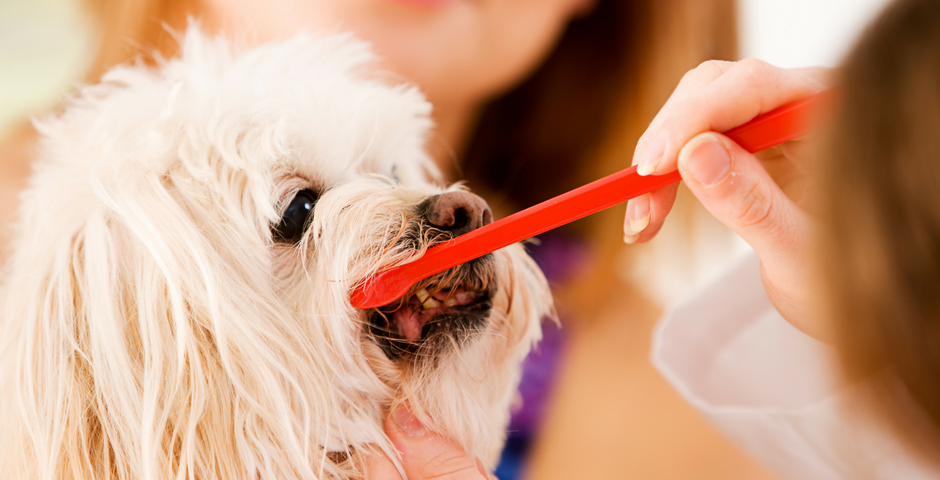
Protecting Your Pet From Toxic Mushrooms
January 15, 2018
Six Tips for a Stress Free Veterinary Visit
February 20, 2018February is pet Dental Health month. Consider how often you care for your teeth . . . Brushing daily, flossing, mouthwash, regular trips to the dentist. There are a lot of things you do to take care of your mouth on a daily basis. There are a lot of things we do for our pets regularly too. Veterinary visits, good food, vaccines, walks, and toys. But how often do we consider the health of their mouths? If you currently do not have a routine for caring for your pet’s dental health, like regular teeth cleaning, please read on to learn why dental health is so important and what you can do to start a routine.
The basics: periodontal disease in pets
Periodontal disease is the medical term to define inflammation and disease of the supporting structures of the teeth. This includes the gums, bones, and ligaments that keep the teeth stable and in place.
What causes periodontal disease?
Every day the bacteria in our pets’ mouths and saliva make a sticky, soft build up called plaque. Plaque is easily brushed away with a toothbrush and pet toothpaste. However, when left untouched the minerals in the saliva cause the plaque to harden into hard calculus (also called tartar). This calculus cannot be swept away with tooth brushing.
While the plaque and tartar is unpleasant to look at, it is only the start of the problem. Once the plaque and calculus reaches underneath the gum line, the bacteria has a chance to wreak havoc in your pet’s mouth. When under the gum line, the bacteria releases toxins and causes your pet’s body to have bad breath and potentially an immune response. The responses the body has can vary and can range from mild to severe.
What are issues caused by periodontal disease in pets?
A common early sign of periodontal disease in pets is gingivitis. Gingivitis is the inflammation and reddening of the gums. Gingivitis can range from mild to severe. Without knowing it, your pet could already have gingivitis. Mild gingivitis can cause a slight swelling and reddening of the gums. While severe gingivitis can cause gums to bleed when your pet eats or chews.
Other issues from periodontal disease can be more severe. The toxins and bacteria that reach under the gum line can cause bone loss, infection of the bone, fistulas (holes in the jaw bones), and abscesses (pockets of pus at the root of the tooth). The big challenge for a pet owner working to maintain pet dental health is that many of these issues of the mouth are difficult to catch unless you are checking your pet’s mouth on a regular basis. Pain and loss of teeth are other potential issues that may develop from periodontal disease. The pain from infection can cause your pet to have a loss of appetite and thus resulting in rapid weight loss. Loss of teeth can also cause issues in your pet’s ability to chew and/or pick up food. What’s more, is that the issues of the mouth can spread to affect your pet’s entire body. If severe enough, the infections of the mouth can cause organ damage to the heart, liver, and/or kidneys.
Where do I start with caring for my pet’s teeth?
The first step with oral care for your pet is to schedule a visit with your veterinarian. An important reason to do so is that your veterinarian will be your partner in making the best effort to maintain your pet’s dental health. At the visit, your vet will take a look at your pet’s teeth. While this is not a cleaning or a detailed oral exam, this visual gives your veterinarian an idea of how much medical treatment your pet will need to obtain optimal oral health and discuss what home care options will work for you and your pet. Read on to learn about what options are available for dental care.
A dental cleaning:
Dental cleaning for dogs and cats must be done under full general anesthesia for several reasons. The most important reason is that once your pet is fully anesthetized, your veterinary team is able to evaluate all of your pet’s teeth from every angle, can do a thorough cleaning around all surfaces of the teeth (removing that plaque and tartar from under the gum line), and find issues in your pet’s mouth that she wasn’t able to see while your pet was awake.
A cleaning may include taking dental x-rays. This is to check the health of the bone and the tooth root. In some cases, there may be clues that the root of the tooth is infected or that the jaw bone has an infection. The only way to determine whether or not there is truly an issue is to take an x-ray.
Dental extractions are also a potential option, especially if your veterinarian is concerned about severe periodontal disease. Extractions are when the teeth are removed from the mouth. This is an option when the tooth is severely infected, broken, or has lost all bone and ligament support and can no longer be healthy functional and pain free in the mouth.
Most veterinary hospitals are capable of handling most dental procedures. However, in some circumstances a referral to a dental specialist will be made. Veterinary dental specialists are veterinarians that are board certified in dentistry. Some dental cases are very complicated and require the hands of a specialist. Veterinary dentists are also capable of performing procedures that your regular veterinarian cannot (i.e. root canals, complicated extractions, crowns).
At home tooth brushing:
Your veterinarian will tell you that the best habit to ensure pet dental health is daily tooth brushing with a toothbrush and toothpaste specifically designed for pets (toothpaste for people contain fluoride and artificial sweeteners that can be harmful for pets). It’s best to start pets off learning the routine of brushing their teeth when they are young. If you want to start your adult pet with a tooth brushing routine, it is possible to teach them a tooth brushing routine. To learn more about how to get into a routine or for tips and tricks on teaching pets about tooth brushing call your veterinarian.
Dental chews, food, and oral rinses:
Perhaps you have a pet that refuses to get into a tooth brushing routine. There are products available that can help keep your pet’s mouth healthy. These products range from chews with unique shapes to products you add to your pet’s food or water. But buyer beware, these products may not do what they claim. Luckily, pet parents can look for the VOHC seal of approval. The VOHC (Veterinary Oral Health Council) is a group that verifies pet dental products do what they claim. VOHC.org is another resource pet parents can use to research what products are available for pet dental health. If you decide to check this website, be aware that the website will also list prescription products as well. These products will require a prescription signed by your veterinarian. However, if you find a product that you are curious about or that does require a prescription bring it up to your veterinarian.
Exotics and Pocket Pets:
Let’s not forget that oral health extends to our winged, scaled, and pint sized pets as well. The size of our smaller pets does make dental and oral health care more challenging in comparison to dogs and cats. Just like with our larger pets, be sure that you are taking your pocket pet or exotic pet into the veterinarian once a year. Veterinarians will be able to evaluate oral health and they have equipment to aid them in looking into the mouths of smaller pets. Because exotics and pocket pets require specific care based on their species, options for care vary greatly. Diet, housing, and genetics all play a role in what is required for optimum dental health. Check with your veterinarian at your pet’s yearly visit to see if there are things you can do to enhance your pets oral health at home

